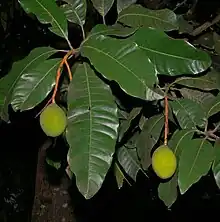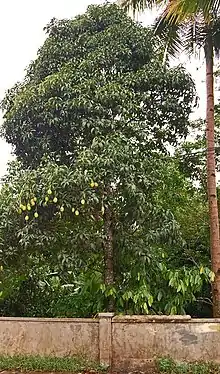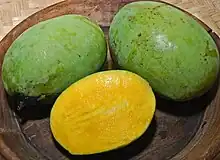Mangifera odorata
Mangifera odorata (commonly known as kuini,[3] kwini, kuweni, kuwini, kuinin, or Saipan mango[2]) is a species of plant in the family Anacardiaceae.[1] It is commonly found along coastal towns or travel routes in Malaysia, Indonesia. [4] "Also found in Peninsular Thailand, South Sulawesi and in Philippines on South coast of Mindanao, in Sulu Archipelago and neighboring islands".[4] "It is a well known fruit tree commonly cultivated in villages throughout Southeast Asia".[5]
| Mangifera odorata | |
|---|---|
 | |
| Scientific classification | |
| Kingdom: | Plantae |
| Clade: | Tracheophytes |
| Clade: | Angiosperms |
| Clade: | Eudicots |
| Clade: | Rosids |
| Order: | Sapindales |
| Family: | Anacardiaceae |
| Genus: | Mangifera |
| Species: | M. odorata |
| Binomial name | |
| Mangifera odorata | |
M. odorata has a skin that is yellow to green in colour.[4] The flesh of the fruit has an orange to yellow colour and is sour or sweet when eaten.[4] The fruits are round in shape and have a smooth skin that range from yellow-green.[4][6] The tree flowers have a pleasant fragrance.[4][6] The fruits are round or oblong in shape and have a skin that ranges from yellow-green.[4][6]
Description

Morphology
Mangifera odorata is a fruit plant that grows approximately 10–15 m in height, hardly ever growing past 20 m.[4] The crown has a wide round shape.[4] The trunk stands in an upright straight position that appears to have a grayish colour "containing an irritant sap".[4] Leaf morphology is "oblong-lance shaped" that has a "non-wavy edge".[4] Veins are also noticeable on the leaf.[4]
The plant has flowers are approximately 6 mm wide, emit a pleasant scent as well as appear to be yellowish-green in colour.[4] The rachis has a reddish-brown colour.[4] Petals are lance-shaped and at the base have a yellowish colour but turn dark red later on.[4] The apex or tip of the petal is pale pink in colour.[4] The sepals which appear to be brown-red or partly green in colour look oval shaped and are roughly 3–4 mm long.[4] Within the flower, there is 1 fertile stamen that serve in reproduction and is about 5 mm in length.[4] The staminodes which are approximately 1.5–2 mm long.[4] Another reproductive organ called the ovary is round in shape, yellowish to dark red and about 3–5 mm in length.[4] The pollen is "elliptic and tapering towards poles"[6]

The fruit has a yellow to green skin colour.[4][6] When it is ripe the skin turns green.[6] The flesh is orange to yellow and can taste sweet or source when consumed.[4] The seed inside is both flat in shape with a hairy/fibrous surface.[4]
Origin and distribution
The exact origins of Mangifera odorata are unknown.[4][9] However, the species represents a hybrid between Mangifera indica known as the Indian mango and Mangifera foetida which is known as the horse mango.[4][5][10] M.odorata is native to tropical Asia and can be found in areas such as Philippines, Peninsular Thailand, South Sulawesi, Sulu Archipelago and other close islands".[4] "In Southeast Asia it is an introduced species".[5]
Habitat
Mangifera odorata thrives in tropical wet climates which have both heavy and moderate rainfall.[4] However, they are unable to survive and grow in places that have continuous dry climates.[4] M. odorata is common in cultivation but does not normally grow in the wild.[4]
Pests
Mangifera odorata is known to be a major host of Bactrocera dorsalis, Ciripestis eutraphera, Coptotermes, Coptotermes cuvignathus, Cryptorhynchus frigidus, Deanolis albizonalis, Marasmiellus scandens and Marasmius crinis-equi.[11]
As food
M.odorata is a fruit which can be consumed.[9] While it can be consumed in its raw form, the fruit is usually made or incorporated into something else such as chutneys.[5] M. odorata fruit pulp is also a good source of nutrition.[12] When M.odorata has not reached maturity, its pulp is a good source for "dietary fibre, vitamin C, vitamin E".[12] The mature pulp is good to eat because of "protein, ash, fat, soluble carbohydrate and B vitamin".[12] The fruit's seed kernel is "rich in fat, protein, carbohydrate, and ash".[13] The peel or skin is a great source of "fibre, minerals, β-Carotene and ascorbic acid".[13]
Conservation status
They are considered to be data deficient and are not label as endangered, threatened, or extinct.[1] Their genetic material is stored in germplasm repositories where it may be used for future cultivar and research uses.[9]
References
- World Conservation Monitoring Centre (1998). "Mangifera odorata". IUCN Red List of Threatened Species. 1998: e.T31401A9630399. doi:10.2305/IUCN.UK.1998.RLTS.T31401A9630399.en. Retrieved 15 November 2021.
- "Mangifera odorata". Germplasm Resources Information Network. Agricultural Research Service, United States Department of Agriculture. Retrieved 27 May 2017.
- USDA, NRCS (n.d.). "Mangifera odorata". The PLANTS Database (plants.usda.gov). Greensboro, North Carolina: National Plant Data Team. Retrieved 27 May 2017.
- Bompard, JM (1991). Mangifera odorata Griffith. Wagenigen, Netherlands: Verheij EWM, Coronel RE, editors. pp. 218–220.
- Teo, L. L.; Kiew, R.; Set, O.; Lee, S. K.; Gan, Y. Y. (2002). "Hybrid status of kuwini, Mangifera odorata Griff. (Anacardiaceae) verified by amplified fragment length polymorphism". Molecular Ecology. 11 (8): 1465–1469. doi:10.1046/j.1365-294X.2002.01550.x. ISSN 0962-1083. PMID 12144666. S2CID 21114338.
- Sankaran, M.; Dinesh, M. R.; Chaitra, N.; Ravishankar, K. V. (2018). "Morphological, Cytological, Palynological and Molecular Characterization of Certain Mangifera Species" (PDF). Current Science. 115 (7): 1379–1384. doi:10.18520/cs/v115/i7/1379-1386. ISSN 0011-3891. S2CID 132914531.
- Djatmiko, W. A. (2007-12-28), Mangifera odorata, fruiting tree. Pandeglang, Banten (west Java), Indonesia, retrieved 2020-04-10
- Djatmiko, W. A. (2008-01-30), Mangifera odorata from Bogor, West Java, Indonesia, retrieved 2020-04-10
- Knight, Robert J.; Schnell, Raymond J. (1994). "Mango Introduction in Florida and the 'Haden' Cultivar's Significance to the Modern Industry". Economic Botany. 48 (2): 139–145. doi:10.1007/BF02908201. ISSN 0013-0001. JSTOR 4255600. S2CID 20407156.
- Yonemori, K.; Honsho, C.; Kanzaki, S.; Eiadthong, W.; Sugiura, A. (2002). "Phylogenetic relationships of Mangifera species revealed by ITS sequences of nuclear ribosomal DNA and a possibility of their hybrid origin". Plant Systematics and Evolution. 231 (1/4): 59–72. doi:10.1007/s006060200011. ISSN 0378-2697. JSTOR 23644347. S2CID 23331942.
- "Mangifera odorata (kurwini mango)". 2020. Retrieved April 11, 2020.
- Gámez, Ignacio Barbosa; Montoya, Karla P. Caballero; Ledesma, Noris; Ayerdi, Sonia G. Sáyago; Magaña, María de Lourdes García; Wettberg, Eric J. Bishop von; Montalvo‐González, Efigenia (2017). "Changes in the nutritional quality of five Mangifera species harvested at two maturity stages". Journal of the Science of Food and Agriculture. 97 (14): 4987–4994. doi:10.1002/jsfa.8377. ISSN 1097-0010. PMID 28406526.
- Lasano, Nur Fatimah; Hamid, Azizah Haji; Karim, Roselina; Dek, Mohd Sabri Pak; Shukri, Radhiah; Shazini Ramli, Nurul (2019). "Nutritional Composition, Anti-Diabetic Properties and Identification of Active Compounds Using UHPLC-ESI-Orbitrap-MS/MS in Mangifera odorata L. Peel and Seed Kernel". Molecules. 24 (2): 320. doi:10.3390/molecules24020320. ISSN 1420-3049. PMC 6359265. PMID 30654598.
![]() Media related to Mangifera odorata at Wikimedia Commons
Media related to Mangifera odorata at Wikimedia Commons
